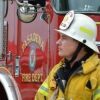You don’t have to look far to find widespread, generalized fear. It’s evident all over our country and throughout the world. We seem to have good reason: epidemics, political unrest, government mistrust, economic instability, crime—all are creating fear and anxiety with most everyone I know.
Allowed to fester and grow, fear can become unhealthy in the extreme. It can stop us in our tracks, keeping us in unhealthy relationships, jobs, situations and addictions. Fear traps us in cycles of negative thinking: “I am not good enough,” “no one loves me,” “I’m incapable,” “I’m on my own.” We allow ourselves to be convinced the world is a bad and frightening place. We retreat.
You know what this looks like. Television and social media put this sort of soul-crushing fear on full display. In fact, they profit from it!
Widespread fear is understandable on some level: The world is changing fast, and any change can be scary. Some of the challenges we currently face as a society and as individuals are objectively terrifying. It would be irrational to, for example, consider the very real possibility of nuclear war without a sense of fear and dread.
That’s because fear is a natural, built-in system that warns us of impending danger. Healthy fear prepares us to react—to fight, flee or freeze. The trouble is, we didn’t evolve this amazing system for the modern world as such. Those sensations that would have meant the difference between life and death in a world full of dangerous animals and unforgiving environments—saber-tooth tigers and vast savannahs—can seem out of place in times of unprecedented convenience and abundance.
While fear can be a powerful and effective prompt to take action, providing a momentary burst of focus and energy and urgency, it’s a lousy, and exhausting, framework to adopt long term. As we seek control and constants in our lives, our worst fears are often revealed. The irony is that in seeking perfection, which is unattainable, we increase our own stress, anxiety and anger. Friends and family begin to distance themselves, thus reinforcing our fears. The world can soon seem—not just seem, but become—a lonely, cruel and unsafe place.
The challenge nowadays, therefore, is to manage these powerful instincts so that they can serve us. I can tell you from personal experience, this isn’t always easy. The cycle of stimulus-emotion-reaction, once so essential to human survival, can become like a bad drug. People become addicted to rollercoaster of fear-based emotion long past it’s actual utility. A person suffering on the rollercoaster of reactivity is desperate for relief. All too often downregulation comes in the form of alcohol, drugs and other unhealthy coping mechanisms.
The Wildfire Metaphor
Here in California, wildfire comes with the landscape. In many ways, wildfire is like fear: It is both a natural and necessary function of the environment, as well as an increasingly deadly threat to the people and animals who live here. Fear spreads like wildfire: It begins with a small, perhaps innocuous, start; then it’s out of control. Tiny embers swirl all around threatening more fire wherever they may land. Resources are limited, and extinguishing one fire means allowing others to potentially run their course.
The first step, in fear and in wildfire, is to acknowledge them. They will happen; they are natural. While it’s often healthy to experience fear as such, it’s necessary to move on from it as well. What is your fear telling you? Can you mitigate a threat? Or must you come to accept a difficult truth (e.g., death, taxes)?
In other words, we must relearn to use fear as a tool in our favor—scary, yes, but necessary too. Fear often precedes times of great human potential and growth, just as in nature. Consider the Giant Sequoia. These are the largest trees on earth and can live for 3,000 years. But they can’t reproduce without fire. Regular burns keep forests healthy. They clear underbrush and create nutrients. Likewise, for people to flourish they too must experience growth and renewal, and that entails facing fear.
As with wildfire, we must co-exist with our fears to keep them in a healthy balance. Just as there is a season and there are areas for suited for burns, there are times and places when fear is not just acceptable but essential. Fear can be your best friend!
A Ready Team
Healthy perspectives on fear and wildfire benefit from trusted partners. Firefighters work with forestry professionals, ecologists and meteorologists to better understand the lay of the land. When a fire starts, they evaluate the factors at play to arrive at a plan. In some cases, they might let the fire burn. In others, they will throw everything they’ve got at a fire—air resources, evacuations, multi-agency response—to get it extinguished quickly. Having good information and trusted sources makes all the difference.
Your mental health is no different. Support often comes in the form of friends, family, peer support and colleagues. When fears press a little too hard, it might be time to call in a professional. Better to deal with it now than to let it spread like wildfire.














